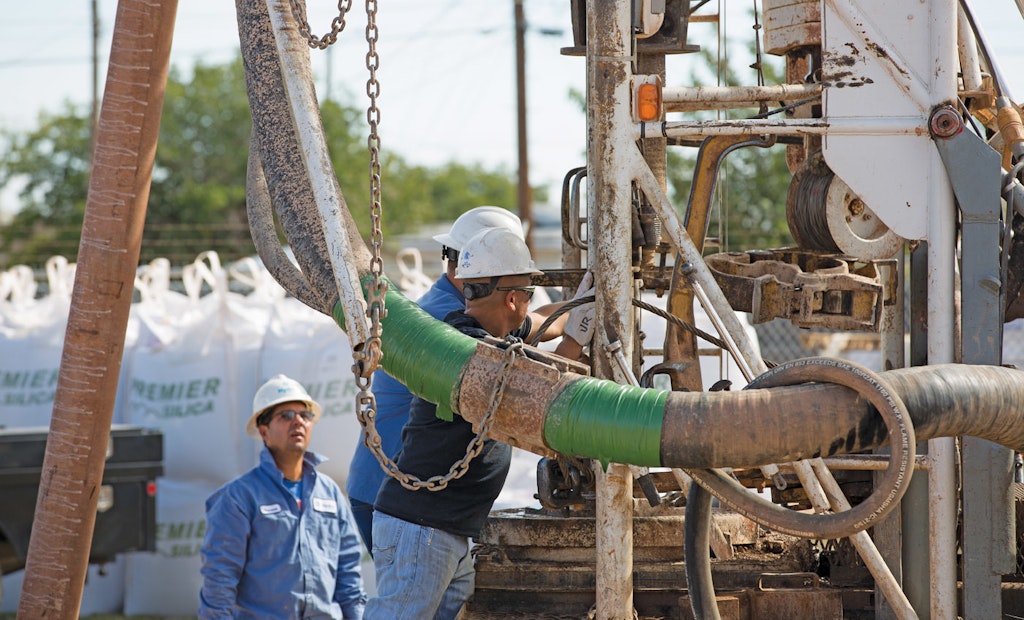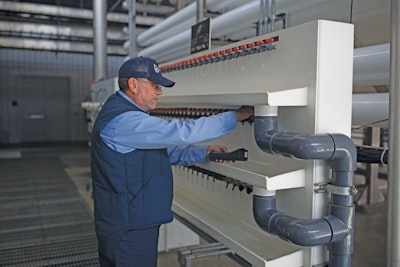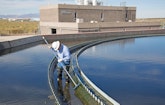
A contracted well drilling crew drills a replacement well for El Paso Water, which has invested heavily in ensuring a reliable, quality water supply for future generations. (Photography by Marcos Fernandez)
El Paso (Texas) Water’s winning formula for water sufficiency goes something like this: Blend one part leadership and one part education. Add expertise in hydrology. Constantly tinker with the recipe. Optional ingredient: prayers for rain.
“When people come visit us from all over the world, they soon see we have no technological secrets, no black boxes,” says Gilbert Trejo, chief technical officer for El Paso Water, alluding to official delegations from Brazil, Israel, China, Iraq, Singapore and other countries. “We are just doing a lot of things that make sense.”
Doing sensible things is not every city’s legacy. How El Paso earned an international reputation for sensibly meeting the water needs of the community is a story that stretches back 65 years, according to Lisa Rosendorf, the utility’s chief communications and government affairs officer. “In 1952, there was a decision made by city leadership to insulate the water utility from some outside pressures by creating a public service board. The new board was less subject to political swings.”
Given this freer rein to manage, the utility’s chief executive officer and seven-person board could plug their financial, engineering, management and environmental skills into long-term strategies. Consequently, they have pursued plans without worrying that a water-sourcing plan might not bear fruit for several political cycles. A typical local politician might be interested in a five-year plan, but the utility can look ahead 50 years and prepare for it.
As a result, El Paso Water invests resources in real-time hydrological programs at the same time it launches longer-term projects to ensure water is there for future generations. This planning and implementation process constantly evolves. The utility can supply the 130,000 acre-feet of water that residents will consume this year with 20,000 acre-feet to spare. However, by 2070, an additional 70,000 acre-feet will be needed to meet the needs of the growing city. Water sufficiency is a moving target, and El Paso Water planners keep moving with it.
Supplementing supply
A cursory glance at a map can offer a misleading picture of El Paso’s water situation. The map plainly shows that the almost legendary Rio Grande — “Big River” in Spanish — runs past the city. It is one of the longest river systems in the country, meandering from its Colorado headwater just east of the Continental Divide down through New Mexico and El Paso clear to the Gulf of Mexico. A river of that size might seem to be an ample water source. If El Paso were the only municipal drain on the river, it might be.
The reality is that the river’s snow-melt runoff water is tapped by almost every potential consumer the river touches. As a result, the river is a depleted water source by the time it reaches El Paso. Furthermore, droughts periodically drop the water level to insufficient levels — the river ran dry in El Paso as recently as 2012. In a normal year, the river can supply half of the water El Paso needs. In dry years, the Rio Grande’s contribution shrinks dramatically or disappears altogether. Water demand doesn’t ebb, however, so El Paso Water at times supplements its supply with water from the Hueco and Mesilla aquifers that underlie the region.
About 9 inches of rain falls on the area each year. In drought years, Hueco’s contribution to the total water supply almost doubles. This drawdown on the aquifer is not a sustainable solution because aquifers eventually can be tapped out, too — even big ones like Hueco, which is about 200 miles long and 25 miles wide. To complicate matters further, the Hueco’s water is not all drinkable.
“What we tell our public is that in the Hueco, we have 10 million acre-feet of freshwater and 30 million acre-feet of brackish water,” says Scott Reinert, the utility’s water resource manager. Brackish water by definition contains measurable amounts of salt — 1 to 30 parts per thousand — that’s not as salty as ocean water but neither healthful nor tasty.
El Paso Water can’t mandate that snow and rain fall to replenish the river, so the utility concentrates on what it can partly control: the underground reservoirs. To that end, the utility pursues two related water supply objectives: maintain the Hueco aquifer’s freshwater volume and keep brackish water at bay. An important step in meeting these objectives was development of the utility’s water reclamation program.
Water reclamation
In 1985, the utility’s Fred Hervey Water Treatment Plant began to return processed water to the aquifer. As the utility declares online, “…water is too valuable to be used only once.” Some 10 million gallons of reclaimed water are being sent underground each day to replenish Hueco — more than 20 billion gallons so far.
Water reclamation is, in fact, one of the acclaimed parts of El Paso’s international water success story. The utility is credited with operating one of the world’s first wastewater treatment plants whose product meets human consumption standards — that is, undrinkable water is made potable. Four plants now process secondhand water, some of it injected into Hueco and the rest used in city parks, golf courses, fire hydrants, street sweepers, industrial cooling towers, and commercial landscaping. Some 6 million gallons of reclaimed water are utilized across the city’s mesa and valley every day.
Brackish water is the other utility board focus. Ten years ago, the utility joined with officials at the Army’s nearby Fort Bliss and opened a $92 million desalination plant, the world’s largest inland facility to remove salt from water. It is a relatively high energy-demand operation because it employs reverse osmosis technology. As a result, the plant typically is operated at a low production level — say, 10 million gallons a day — to limit the energy demand.
The desalination plant has the capacity to produce 28 million gallons of freshwater per day. “Our future increasingly is in our desalting,” Reinert says. The byproduct of the desalination process is concentrated brine, which is injected in safe areas deep underground. However, a new private facility next to the plant is beginning operations to create commercial products from the salts and minerals, with freshwater being returned to the utility. This could be a pivotal manufacturing process for both the company and utility.
Yet, converting brackish water to drinkable water is just part of the desalination plant’s immediate purpose. “Our goal is to preserve our freshwater so we will always have a freshwater aquifer — water that we don’t have to desalt,” Reinert says. Therefore, the water pulled up to the plant is collected from underground brackish water that’s flowing toward the freshwater portion of the aquifer. “We try to keep the brackish water from intruding into our freshwater source, using our desalination plant as much as we need to hold the line.”
Conservation efforts
This high-stakes drama involving hydraulic gradients and commingling of good and bad water is played out a few hundred feet in the earth, but the implications of it are in full view of every person living in El Paso or soldiering at Fort Bliss. It can be seen in city ordinances regulating water usage and other daily reminders that residents are living in a desert.
Water conservation became a way of life here after the El Paso City Council instituted an “aggressive” conservation program in 1991. Rosendorf says there was a fear factor in adoption of that ordinance — a prediction that El Paso would run out of water by 2009. That raised a general alarm and eventually resulted in year-round water restrictions and a rate structure that penalizes customers for high water consumption. In the quarter century since the conservation program was instituted, per-person water consumption in El Paso has been cut by 30 percent to 128 gallons per person per day. The hope is that residents will give up another 10 gallons per person per day.
They might. Despite the hassle, El Paso customers recognize that they enjoy a low monthly water bill. “We have the scarcest water supply in the region but have some of the lowest rates,” Reinert notes. The average 2016 monthly bill in El Paso — not including wastewater or stormwater billing — was about $28 versus $65 in Austin, $46 in Houston, and $35 in Fort Worth. For that matter, the cost of water is less than in Tucson, Arizona, ($41) and Albuquerque, New Mexico, ($30). Even if a proposed 7 percent increase in the water rate is approved, this ranking of city rates will hardly change.
The proposed extra revenue will fund expansion of the desalination plant and design of an advanced water purification plant that will increase utilization of reclaimed water for drinking. It also will pay for the purchase of land and water rights in another county 100 miles from El Paso for eventual importing of water. A measure of how effectively the utility has managed its current resources is that importing water won’t begin till 2040 — 10 years later than originally forecasted. Such future-dating is a benchmark of progress in the struggle for water sufficiency.
Long-term views
What are the lessons in all this for other water utility companies and water-stressed cities? One of them is long-range planning — what Rosendorf calls “having an eye for the long term.” Another lesson is diversification. “Relying on one source of water is detrimental to any community,” Reinert says. “When we saw the Hueco water level declining, we started a 50-year plan. Hueco needs loving care and attention, and we are providing it. We slowed the decline of the aquifer when we began the other projects.”
Trejo says leadership is key. He cites city and utility boards that have overseen the landmark desalination and water reclamation programs in El Paso. “And our advanced purification plant is going to be the first of its kind to treat reclaimed water to safe drinking standards and distribute it directly to customers. We are the pioneers. Leader-ship is taking on challenges and not being afraid to be the first one to do the right thing for the community.”
There are plenty of challenges remaining for El Paso, with the city population projected to reach 1.4 million by 2070. But the prospect of so many more water users doesn’t faze Trejo. “We are not in the business of controlling the city’s population. Our job is to provide water to the city, which we will do with the different strategies we have in place.”
Education promotes conservation
Every community must be persuaded to buy into any program that calls for common sacrifice. El Paso, Texas, residents seem to have bought into the notion that its finite water supply shouldn’t be frivolously used.
Water scarcity is no mystery to people living in this desert community. Rainy days are rare, and water is a blessing. Still, voluntarily taking short showers and reusing water when possible is not a natural human instinct, even when water rates are jacked up to penalize overconsumption.
El Paso Water’s chief communications and government affairs officer, Lisa Rosendorf, oversees the utility’s water conservation program. She says when the city implemented a demanding water conservation program more than a quarter century ago, a gradual community acceptance of the new norm followed. “There is an appreciation now that we need to conserve. Asking people to conserve our water resource is still challenging, but it helps when you have a community that has its eyes open.”
Rosendorf says education “has been a huge component” of the city’s successful conservation policy. “We have a learning center that 5,000 students go through every year. They are learning at a young age the value of water.” The utility’s learning center is adjacent to its Kay Bailey Hutchison Desalination Plant and contains 16 interactive exhibits, ranging from general information about the Chihuahuan Desert to more technical explanations of desalination and aquifers. The 30,000-square-foot building also has a 250-seat auditorium and a training center.
In essence, the educational programs build and maintain support for smart water usage, which feeds continued progress. “The progress the city has made in water conservation and use all goes back to community acceptance,” says Gilbert Trejo, the utility’s chief technical officer.
Divided by a river, connected by an aquifer
El Paso is a border town situated in the far southwest corner of Texas. Just how far southwest is illustrated by the fact that the city is closer to Los Angeles than it is to the eastern border of Texas. More pertinent is that El Paso is just across the U.S.-Mexico border from Ciudad Juárez, the largest urban center in the Mexican state of Chihuahua.
The neighboring communities have had a long relationship. The first bridge to span the Rio Grande and connect them was built 250 years ago. They are also connected in another way: The two cities share a common water source, the Hueco aquifer. In fact, because Ciudad Juárez doesn’t have access to the Rio Grande, its entire urban area draws water solely from the aquifer. We’re talking 1.5 million people.
The good news is that El Paso and its neighboring city are staying in touch about their common concern for the aquifer and future water supplies. “We work with our counterparts across the border,” says Gilbert Trejo, chief technical officer for El Paso Water. “Their staff is generating models that — over the last 15 years — have proven very similar to ours. We are sharing information.”
Cooperation notwithstanding, the Mexican city’s total reliance upon the Hueco aquifer doesn’t make things any easier for El Paso. Accordingly, El Paso Water’s 50-year regional water plan factors in Ciudad Juárez’s current and anticipated demand.
“The demands of Ciudad Juárez on the aquifer are much larger,” Trejo notes. “It is important for us to understand their impact on Hueco.”








